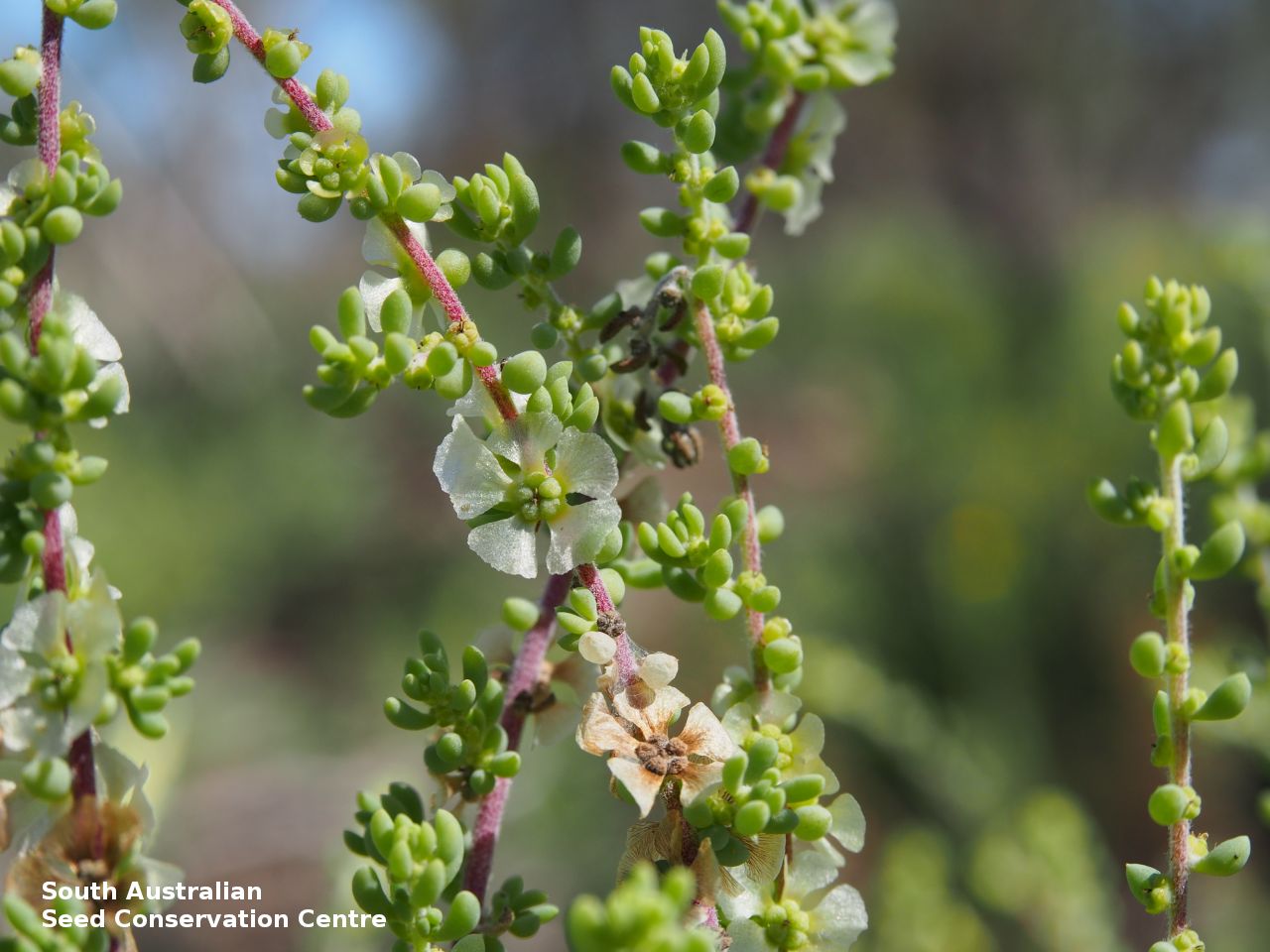Small-leaf Bluebush,
Short-leaf Bluebush
Display all 11 images











Regional Species Conservation Assessments per IBRA subregion.


Least concern
Near threatened
Rare
Vulnerable
Endangered
Critically endangered
Extinct
Data deficient
Adelaide
Arkaroola
Ceduna
Coober Pedy
Hawker
Innamincka
Marla
Marree
Mount Gambier
Oodnadatta
Renmark
Wudinna
Keith
Yunta
Display IBRA region text
| Fleurieu (KAN02) | Kanmantoo | Least Concern |
| Mount Lofty Ranges (FLB01) | Flinders Lofty Block | Least Concern |
| Broughton (FLB02) | | Least Concern (Probable Increase) [likes disturbed areas] |
| Olary Spur (FLB03) | | Least Concern (Probable Increase) [likes disturbed areas] |
| Southern Flinders (FLB04) | | Least Concern (Probable Increase) [likes disturbed areas] |
| Northern Flinders (FLB05) | | Least Concern [likes mallee, open areas; doesn't set seed well] |
| Central Flinders (FLB06) | | Least Concern [likes mallee, open areas; doesn't set seed well] |
| Southern Yorke (EYB01) | Eyre Yorke Block | Least Concern (Probable Increase) [likes disturbed areas] |
| St Vincent (EYB02) | | Least Concern (Probable Increase) [likes disturbed areas] |
| Eyre Hills (EYB03) | | Least Concern (Probable Increase) |
| Talia (EYB04) | | Near Threatened |
| Eyre Mallee (EYB05) | | Least Concern |
| South Olary Plain (MDD01) | Murray Darling Depression | Least Concern (Probable Increase) [likes degraded areas] |
| Murray Mallee (MDD02) | | Least Concern (Probable Increase) [likes degraded areas] |
| Murray Lakes and Coorong (MDD03) | | Least Concern [southern edge of range] |
| Lowan Mallee (MDD04) | | Least Concern (Probable Increase) [likes degraded areas] |
| Braemer (MDD07) | | Least Concern (Probable Increase) [likes disturbed areas] |
| Murray Scroll Belt (RIV06) | Riverina | Least Concern (Probable Increase) [likes degraded areas] |
| Myall Plains (GAW01) | Gawler | Least Concern |
| Gawler Volcanics (GAW02) | | Least Concern |
| Gawler Lakes (GAW03) | | Near Threatened |
| Torrens (GAW06) | | Near Threatened [edge of range] |
| Roxby (GAW07) | | Near Threatened [edge of range] |
| Yellabinna (GVD06) | Great Victoria Desert | Near Threatened |
| Yalata (NUL03) | Nullarbor | Near Threatened |
| Barrier Range (BHC01) | Broken Hill Complex | Least Concern (Probable Increase) [likes disturbed areas] |
| Barrier Range Outwash (BHC04) | | Least Concern (Probable Increase) [likes disturbed areas] |
| Bimbowrie (BHC05) | | Least Concern (Probable Increase) [likes disturbed areas] |
| Curnamona (BHC06) | | Least Concern (Probable Increase) [likes disturbed areas] |
| Murnpeowie (STP03) | Stony Plains | Near Threatened [edge of range] |
| Fleurieu (KAN02) | Kanmantoo | Least Concern |
| 6 of 6 subregions | Flinders Lofty Block | Least Concern |
| 5 of 5 subregions | Eyre Yorke Block | Least Concern , Near Threatened |
| 5 of 6 subregions | Murray Darling Depression | Least Concern |
| Murray Scroll Belt (RIV06) | Riverina | Least Concern (Probable Increase) [likes degraded areas] |
| 5 of 8 subregions | Gawler | Least Concern , Near Threatened |
| Yellabinna (GVD06) | Great Victoria Desert | Near Threatened |
| Yalata (NUL03) | Nullarbor | Near Threatened |
| 4 of 4 subregions | Broken Hill Complex | Least Concern |
| Murnpeowie (STP03) | Stony Plains | Near Threatened [edge of range] |
Botanical art
Kath Alcock paintings: 5
Prior names
Suaeda tamariscina
Kochia tamariscina
Enchylaena tamariscina
Kochia brevifolia
Common names
Small-leaf Bluebush
Short-leaf Bluebush
Etymology
'Maireana', after the 19th century French botanist, Adolphe Lemaire and Latin 'brevis', short, 'folia', leaves
Distribution and status
Usually found on slightly saline soil; often recorded in open mallee. Distributed through the Eyre, Yorke and Fleurieu Peninsulas, Murraylands and Flinders Ranges. Native. Common in Victoria, New South Wales and the SW of Western Australia. Mostly recorded in South Australia.
Herbarium regions: Flinders Ranges, Eastern, Eyre Peninsula, Northern Lofty, Murray, Yorke Peninsula, Southern Lofty, Green Adelaide
AVH map: SA distribution map (external link)
Plant description
Erect, short-lived, perennial shrub to 1.5 m high. Leaves alternate, fleshy; obovoid to narrow-fusiform; 2-5 mm long, glabrous. Flowers solitary; glabrous apart from the woolly ciliate lobes. Flowering January - October. Fruits are fruiting perianth glabrous; tube shallowly hemispherical; thin-walled, 2 mm in diameter; wings 5, horizontal, thin, fan-shaped, 2-3 mm long, with delicate brown venation when dry; perianth lobes thick and fleshy, sharply demarcated from the wings. Seeds are circular, brown, convex seeds Seed embryo type is peripheral
Seed collection and propagation
Collect seeds between December and February. Collect seeds when fruits are brown and papery. Check inside several fruits for the presence of well-developed seed before making a collection. Strip or shake fruiting branches into a container. Remove twigs and other plant material. 65% and 84% viability in two collections Germination levels varied from 12% to 86%.
| Location | No. of seeds
(weight grams) | Number
of plants | Date
collected | Collection number
Collection location | Date
stored | % Viability | Storage
temperature | BGA
MSB | 24,600 (29.54 g)
24,600 (29.54 g) | 25 | 9-Mar-2005 | MKJ85
Southern Lofty | 28-Mar-2006 | 65% | -18°C |
BGA
MSB | 11,600 (17.4 g)
11,600 (17.4 g) | 30 | 12-Feb-2005 | MKJ82
Southern Lofty | 28-Mar-2006 | 65% | -18°C |
Location: BGA — the seeds are stored at the Adelaide Botanic Gardens, MSB — the seeds are stored at the Millennium Seed Bank, Kew, England.
Number of plants: This is the number of plants from which the seeds were collected.
Collection location: The Herbarium of South Australia's region name.
% Viability: Percentage of filled healthy seeds determined by a cut test or x-ray.
Germination table:
Display










